
Nikon D4 + Nikkor 200mm f/2 — 1/800 sec, f/2, ISO 6400 — map & image data — nearby photos
Wardrobe Adjustment
Gion area of Kyoto, Japan
I met this young lady several years ago, and was pleased to have a chance to make some photographs for her today. Her easy smile made it all too easy. I'd been borrowing Damien's Nikkor 200mm f/2 since the autumn without having encountered a reason to use it, but today provided the perfect opportunity.

Nikon D4 + Nikkor 200mm f/2 — 1/800 sec, f/2, ISO 4000 — map & image data — nearby photos
Further Adjustments

Nikon D4 + Nikkor 85mm f/1.4 — 1/800 sec, f/1.4, ISO 5600 — map & image data — nearby photos
Drenched in Red
I've barely looked through the images so this'll have to do for now.

Nikon D4 + Nikkor 14-24mm f/2.8 @ 14mm — 1/100 sec, f/6.3, ISO 800 — map & image data — nearby photos
This is the Small One
a gate on the approach to the Todaiji Temple (東大寺の南大門),
Nara, Japan
Dipping into the largely-untapped reservoir of things I want to post about, here are some pictures from a December 2012 visit to the Todaiji Temple (東大寺) in Nara, about an hour's train ride south of Kyoto. I posted a bit from that trip in “That Massive Column in Nara’s Todaiji Temple Is Nothing To Sneeze At”, but it's a visually rich place, so I've been wanting to post much more.
I'd made the trip to take some pictures for a friend who is the author of Lonely Planet's “Japan” guidebook. A few of the photos from this trip made it into the most recent edition. Another friend, Aeron, was kind enough to make the trek with me.
The Todaiji Temple site is impressively large, dating back almost 1,300 years. On the approach we took is a massive wooden gate that seems to exist merely to set you up for the substantially-more-impressive sights that wait beyond.

Nikon D4 + Nikkor 85mm f/1.4 — 1/400 sec, f/1.4, ISO 100 — map & image data — nearby photos
Todaiji in a Nutshell
deer, school kids, big wooden buildings
Looking through the gate you can see another behind, and beyond that the temple's main building towers so high that you can't see the top of its roof.
The gate, called the Great Southern Gate (南大門), is interesting enough in its own right. It was originally built in 962, but the one standing today is a reconstruction built just 815 years ago. (The sign near the top of the photo is new, giving 「大華厳寺」, apparently an old name for the temple.)
Here's a shot exposed to reveal the detail under the roof:

Nikon D4 + Nikkor 14-24mm f/2.8 @ 14mm — 1/100 sec, f/2.8, ISO 5000 — map & image data — nearby photos
Holding Up Well
for 815-year-old construction
As with many temple gates, two guardians flank the sides of the gate. (Wikipedia tells me they're called Kongorikishi, and describes them as “wrath-filled muscular guardians of the Buddha”). They're almost 25½ feet tall, so they're almost 4½ times my height. Their situation is not conducive to good photos, but here's one:

Nikon D4 + Nikkor 50mm f/1.4 — 1/100 sec, f/2.8, ISO 3600 — map & image data — nearby photos
Wrath Filled and Muscular
The other statue, at my back while taking this shot, was carved in 1203. This one dates from the same era, though I couldn't find out for sure what year this one was carved.
Here's a wigglegram to make you feel as if you're there; wiggle your mouse over the image...






















写真の上をマウスで左右にゆっくり動かすといろいろな影響を見えます。
Moving then beyond the gate, you can see the next gate and, far beyond that, the roof of the main temple building...
The deer in Nara can be extremely aggressive, and I can report from personal experience that they have no qualms about coming up behind you to bite the bag out of your hand if you just bought a snack from a vendor. Care should be taken with fingers and small children.
Of course, tourist can't always provide breakfast, so some deer are forced to fend for themselves...

Nikon D4 + Nikkor 85mm f/1.4 — 1/1600 sec, f/1.4, ISO 100 — map & image data — nearby photos
Quick Breakfast

Nikon D4 + Nikkor 70-200mm f/2.8 @ 200mm — 1/400 sec, f/2.8, ISO 400 — map & image data — nearby photos
Small Lake Along the Way

Nikon D4 + Nikkor 70-200mm f/2.8 @ 200mm — 1/400 sec, f/2.8, ISO 250 — map & image data — nearby photos
Untamed
if they were tamed, they'd be giving the deer food

Nikon D4 + Nikkor 24mm f/1.4 — 1/400 sec, f/6.3, ISO 640 — map & image data — nearby photos
In-Camera HDR
HDR was supposed to be this, but here it apparently means “Highly Distorted Reality”
Once you enter the paid area, your get your first clean view of the main temple building, which is stupendously large for an all-wooden building constructed hundreds of years ago....

Nikon D4 + Nikkor 70-200mm f/2.8 @ 70mm — 1/400 sec, f/5, ISO 360 — map & image data — nearby photos
Lots of Tiny Doors
that are actually each colossally large

Nikon D4 + Nikkor 24mm f/1.4 — 1/1250 sec, f/1.4, ISO 100 — map & image data — nearby photos
Incense Burner
there was one at either end of the long approach walkway

Nikon D4 + Nikkor 24mm f/1.4 — 1/400 sec, f/1.4, ISO 200 — map & image data — nearby photos
Aeron and Incense Burner

Nikon D4 + Nikkor 70-200mm f/2.8 @ 70mm — 1/400 sec, f/2.8, ISO 160 — map & image data — nearby photos
Not Too Crowded

Nikon D4 + Nikkor 24mm f/1.4 — 1/400 sec, f/3.5, ISO 1800 — map & image data — nearby photos
Massively Overexposed By Accident
but sort of looks interesting in B&W

Nikon D4 + Nikkor 24mm f/1.4 — 1/2000 sec, f/1.4, ISO 100 — map & image data — nearby photos
False-Color Shot
playing around with this one, I colored the yellow/brown grass green

Nikon D4 + Nikkor 70-200mm f/2.8 @ 200mm — 1/200 sec, f/2.8, ISO 450 — map & image data — nearby photos
Fire Extinguisher at the Ready

Nikon D4 + Nikkor 70-200mm f/2.8 @ 200mm — 1/200 sec, f/10, ISO 250 — map & image data — nearby photos
Roof Detail

Nikon D4 + Nikkor 24mm f/1.4 — 1/320 sec, f/1.4, ISO 100 — map & image data — nearby photos
Lots of Detail
way up there

Nikon D4 + Nikkor 24mm f/1.4 — 1/200 sec, f/7.1, ISO 320 — map & image data — nearby photos
I See You
large incense burner just outside the entrance, opposite the one seen above
To be continued...

This post is a mini review of a couple of bluetooth (wireless connection) speakers I've been using recently, one small “brick” speaker for the home, and a pair of earbuds for the gym.
Above we have the Braven 710. I lifted the (almost-certainly CGI) image from their web site; if I would have not been lazy and instead taken a photo myself, I would have put something there for context so that you can see that it's small... it's about the size of a sort-of-squished hotdog bun.
We like it. It's got great sound from such a small package. I've connected all our phones to it so that we can each use it when we like. It's splash resistant so we can bring it in the bath, and it's easy to bring with us as we do tasks around the house.
It has a lot of extra features, like acting as a portable power brick for small mobile devices, bridging to a non-bluetooth stereo, NFC support, and more. For lots of details, see this review at AppAdvice.com, which is the review that prompted me to buy it. Or, perhaps, this overview video from the company.
I recommend it, but I must point out that the Braven 710 suffers from the same problem that every bluetooth audio device I've ever tried suffers from: “stupid” where “smart user-interaction design” should be. For example, there's no simple on/off switch that you can glance at to see whether the thing is on... you have to press a rubbery button for several seconds and listen for a weird deep rumbling “chirp” from the thing... the nature of the “chirp” tells you whether you just turned it on or off. Wanted to ensure it was on but just turned it on? Repeat.
It overloads its many functions onto just a few buttons. You can see from the image above that there are four buttons on the side: plus, minus, power, play. Yet by combinations of press/hold timing and magic unicorn-horn context, functions these four buttons perform include volume up/down, volume mute/unmute, track skip forward/backward, play/pause, answer a phone call and hang up, pair the unit with a new device, and of course to turn the thing on and off. It's very unsatisfying.
Still, every bluetooth audio device I've encountered suffers from the same problem, so I don't think you'll find anything better.
Pros
- Good big sound for the small, convenient package.
- Splashproof, so we can bring in the bath or outside.
- Easy to bring when on the go.
- Can use to charge your phone in a pinch.
Cons
- Stupid bluetooth-standard user interface design.
I got my Bravin 710 at Amazon.com last month for $166 with shipping. It seems to be $150 at the moment.

Next we have a pair of wireless ear buds, “Mpow® 2nd Gen Sport Bluetooth Stereo Headphone Wireless Headset”, that I use at the gym while working out and stretching.
Wireless buds are extremely liberating, but only if they stay in. I think I have pretty normal ears, but normal ear-buds headphones never, ever feel comfortable nor stay in my ears. I've tried many brands, and they're all not made for me. The worst by far are the latest from Apple (that come with the iPhone 5s)... I can't get them to stay in for even one second... it's as if they're meant to be magnetic and my ears are just not metal.
So, I was thrilled to find that this kind of clip-ish set works perfectly for me. They sort of clip over your ears and so don't require any ear-canal friction, so the shape of one's ear doesn't really matter.
If find them easy to put on and take off, yet when they're on they on and in place through any activity I've tried, including high-speed pushups and gracelessly falling off a balance ball. I can turn my head and crane my neck to the extremes and they stay firmly in place. In this regard I'm extremely satisfied.
Of course, they have the same “stupid UI design” caveat above that applies to all bluetooth headsets. The buttons require some concentration and luck to work while wearing (e.g. to temporarily mute, or to skip a song).
Pros
- STAYS PUT; doesn't fall out of my ears if I blink, or if I twist-n-shout.
- Good enough sound for me (I think it's pretty good).
- Good enough battery life for me (I've never exhausted the battery).
- Easy on / easy off.
- Good range... I can leave my phone in my bag as I move around the gym.
- Small and unobtrusive. You can forget you're wearing them.
- Easy to see you're wearing headphones, so people leave you alone.
Cons
- Easy to see you're wearing headphones, so it creates a barrier to “community”.
- May not be easy to wear with glasses that have thicker temples in the ear area.
- Charging-port cover is a bit wonky, and mine broke off right away. I feel they're better for it, though a day of heavy sweat may have me regret the lack of a cover.
- Stupid bluetooth-standard user interface design.
I got mine at Amazon last month for $23 (shipping included). A great value.
At the same time I'd also gotten two other headsets to test: ECSEM® Mini Lightweight Wireless Stereo Headphones ($25), and Avantree AS8Q Neckband In Ear Sweat-proof Stereo Bluetooth Wireless Headphones ($38). But like any other in-ear buds they just fall out, so once I tried the Mpow ones, I ignored these. Maybe I'll give them to Anthony or something.

Nikon D4 + Voigtländer 125mm f/2.5 — 1/640 sec, f/2.5, ISO 180 — map & image data — nearby photos
“All You Can Drink” Sake Flows Like Water
in my dreams
(however, water does flow like water at the Gekkeikan Sake Museum in Kyoto Japan)
I recently made my first trip to the area of southern Kyoto historically known for its sake production, which likely dates back thousands years. Written on the cup above is “月桂冠” (Gekkeikan), the name of a sake-brewing company founded in 1639.
Gekkeikan sake is ubiquitous in Japan. Here you see its name on barrels outside a temple in the area...
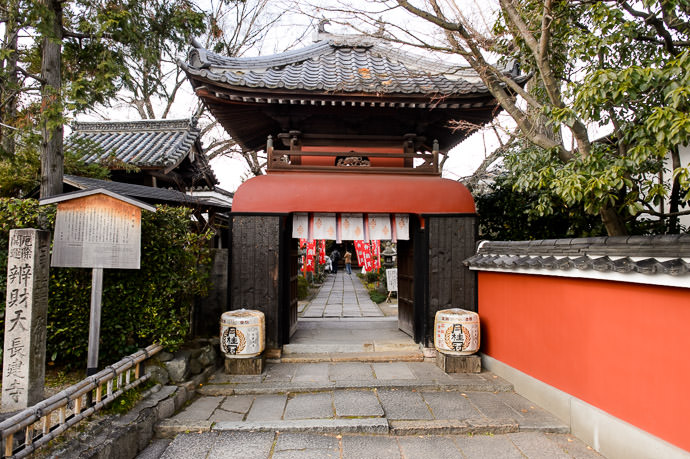
Nikon D4 + Nikkor 24mm f/1.4 — 1/640 sec, f/4.5, ISO 900 — map & image data — nearby photos
Entrance to the Chokenji Temple (長建寺)
“Long Health Temple” supported by sake
It's my understanding that the (certainly-empty) barrels of sake represent a monetary donation from the brewery, to match what in olden times was an actual gift of sake. In either case, the brewery gets advertisement and good karma.
This particular temple is quite small, with a chunk of its area given to a courtyard with a couple of fenced-in features..
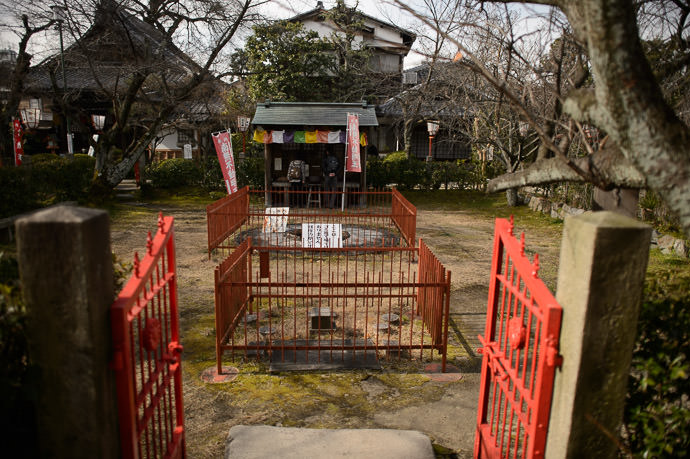
Nikon D4 + Nikkor 24mm f/1.4 — 1/1000 sec, f/1.8, ISO 100 — map & image data — nearby photos
Temple's Courtyard
The courtyard's main attraction is this fire pit with two big, ugly signs:
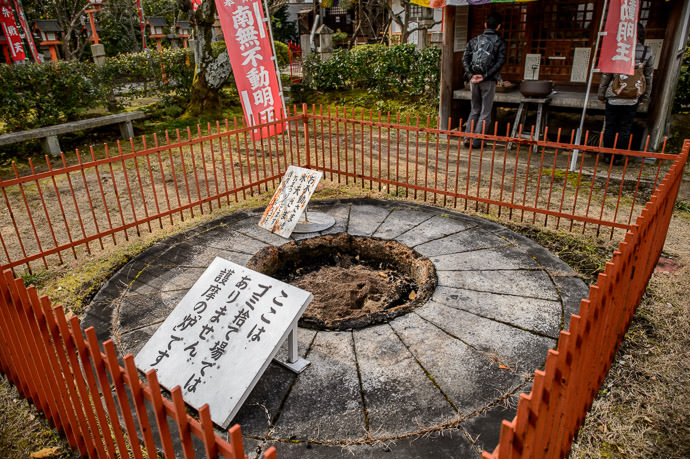
Nikon D4 + Nikkor 24mm f/1.4 — 1/640 sec, f/3.5, ISO 800 — map & image data — nearby photos
Inexplicable
What struck me about this scene was the huge sign in the foreground, which reads "This is not a place to throw garbage. It's a fire pit for ceremonial burning of ceder sticks.", referring to a Buddhist ceremony likely comparable to the Shinto ceremonies shown here and here. My first thought was that such a sign was silly because even a child could instinctively know that the fenced-off area surrounded by precisely-carved stone was not a place to throw your trash. Yet, here was the big sign, so I was left wondering what transpired to cause the owner to feel the need for such a sign. I suppose it's a sad reflection on the state of humanity, even worse than the no-tripods-in-your-possession temple. Sigh.
Anyway, we continued the short distance to an old Gekkeikan factory building now used as a museum...
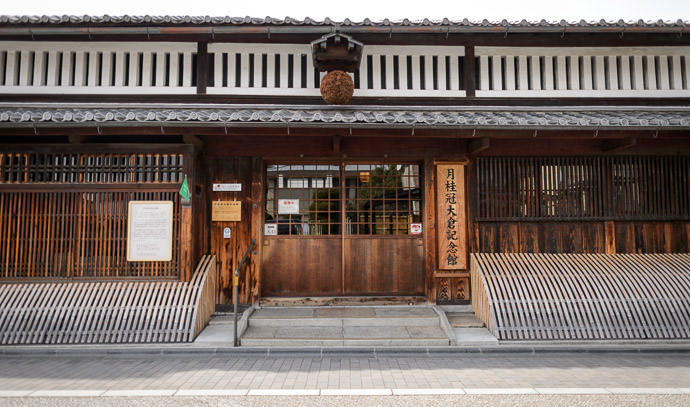
Nikon D4 + Nikkor 24mm f/1.4 — 1/1000 sec, f/1.4, ISO 100 — map & image data — nearby photos
Gekkeikan Okura Memorial Museum
月桂冠大倉記念館
They had water running into a basin, with a sign saying that it was from a deep well that provides water for the sake production. I should have tried the water. Instead, I took pictures of it.
Kyoto friend Alain, who had invited me, spent considerable time composing a photo of the basin from above...
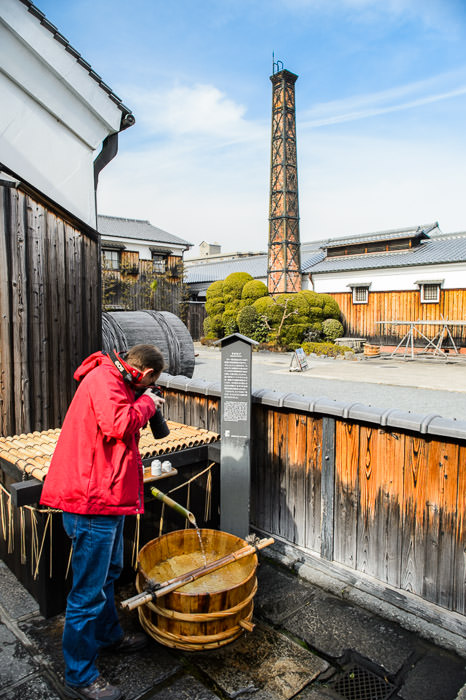
Nikon D4 + Nikkor 24mm f/1.4 — 1/640 sec, f/3.5, ISO 320 — map & image data — nearby photos
Alain and his Basin
Showing no shame, I totally copycatted him and made my own attempt at his shot. I've since seen his result and it's far superior to mine (because, er, he has a better camera? 😉), but FWIW here's mine:
Next to the museum were three huge barrels, the largest of which measuring about six feet across:
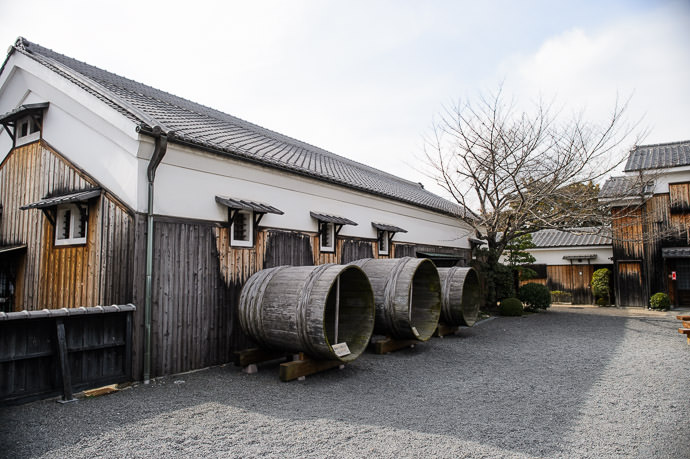
Nikon D4 + Nikkor 24mm f/1.4 — 1/640 sec, f/3.5, ISO 180 — map & image data — nearby photos
Big Barrels
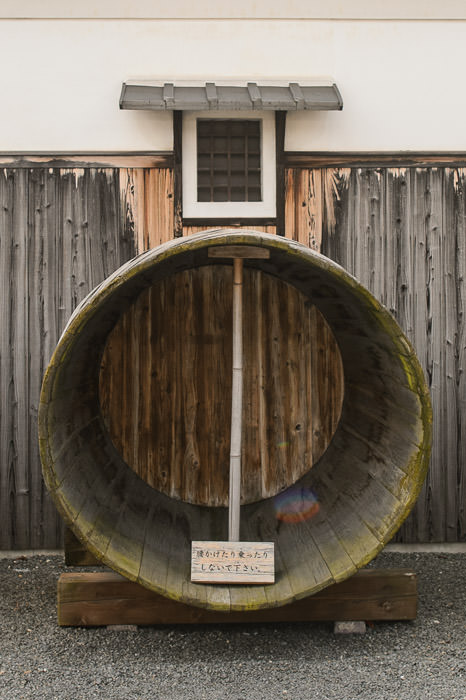
Nikon D4 + Nikkor 24mm f/1.4 — 1/640 sec, f/3.5, ISO 400 — map & image data — nearby photos
Silly Sign #2
“Don't hang on or climb on”
(but, oddly, no mention about going inside)

Nikon D4 + Nikkor 24mm f/1.4 — 1/640 sec, f/3.5, ISO 450 — map & image data — nearby photos
Hand for Scale
Long bamboo strips were woven around the barrel in what appeared to be rings to keep the wooden slats together. I wonder whether it's cosmetic, or whether it could actually hold the slats tightly enough to form a watertight seal(?) It seems improbable, but perhaps they're installed while in some kind of expanded state (e.g. after boiling?) and so constrict as they dry?
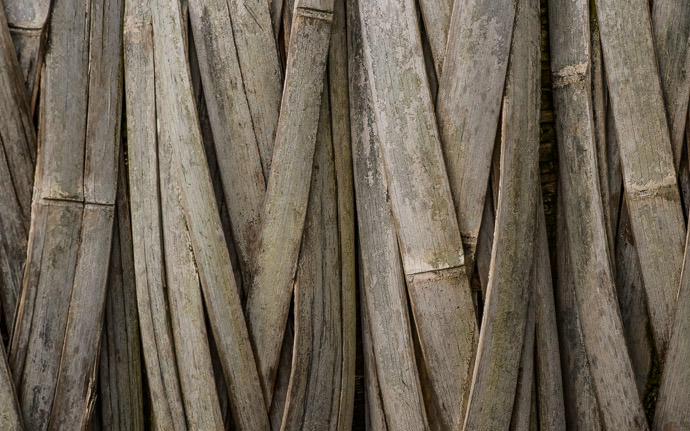
Nikon D4 + Voigtländer 125mm f/2.5 — 1/640 sec, f/8, ISO 2000 — map & image data — nearby photos
Ties that Bind
This is, of course, the answer to the other day's A Woven(ish) “What am I?” Quiz. I'd given the hint that the location name in the image metadata might lead one to an answer, but for the record even with that hint I myself would never have figured it out because I'd never seen the “bamboo binding” thing before.
Inside the small museum (which I'll cover in a separate post) you can see a lot of history about how sake was made in former days. It was nice to see this long-history view of Gekkeikan because in my experience it's always been the ubiquitous cheap sake in convenience stores and restaurants, which has given me the feeling that it's what someone stocks when they don't want to think about quality and just need to mark “sake” off the checklist.
Once you emerge from the display rooms, you're greeted with what was certainly my favorite sign for the day:
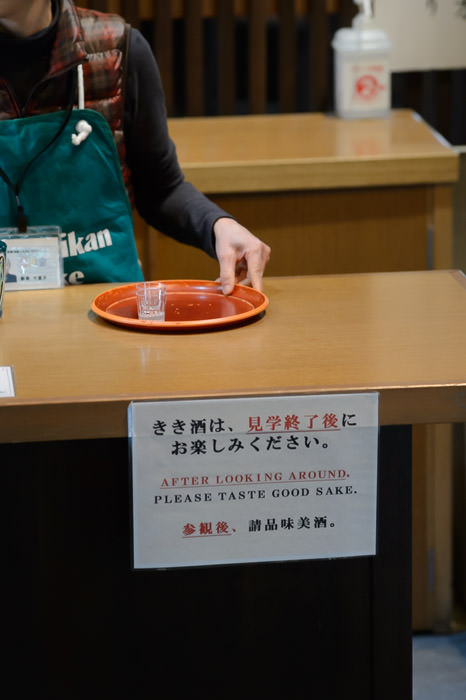
Nikon D4 + Voigtländer 125mm f/2.5 — 1/160 sec, f/4, ISO 6400 — map & image data — nearby photos
Well Okay, I Don't Mind if I Do!
I love that Japanese has a word (kikizake) for “sake for tasting”.
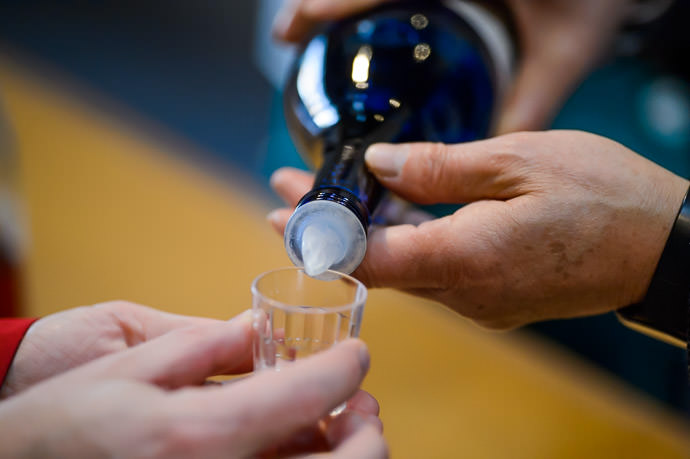
Nikon D4 + Voigtländer 125mm f/2.5 — 1/640 sec, f/2.5, ISO 6400 — map & image data — nearby photos
Pour
( staged for documentation purposes because I was too slow for the real pour )
This calls to mind “A Bunch Of Blurry Pictures of Folks Pouring Wine” and to a lesser extent “A Visit to Suntory’s Kyoto Beer Brewery”.

Nikon D4 + Voigtländer 125mm f/2.5 — 1/400 sec, f/2.5, ISO 6400 — map & image data — nearby photos
“Retro Bottle”
100-year-old bottle design that includes its own detachable drinking cup
Sadly, the subject nor the setting weren't nearly as photogenic as at “Japan’s First Whisky: Suntory’s “Yamazaki” Distillery”.
Just like there's a huge diversity of beer taste (e.g. Guinness Stout compared to Budweiser) and wine (thick sweet red dessert wine compared to a dry white wine), sake tastes cover a very wide gamut, and expanding the range farther is that the taste of many sake changes completely depending on the temperature it's served. So, “research” along these lines could take considerable time, and normally I would not hesitate to do this for my blog readers, but alas, we had to move on.
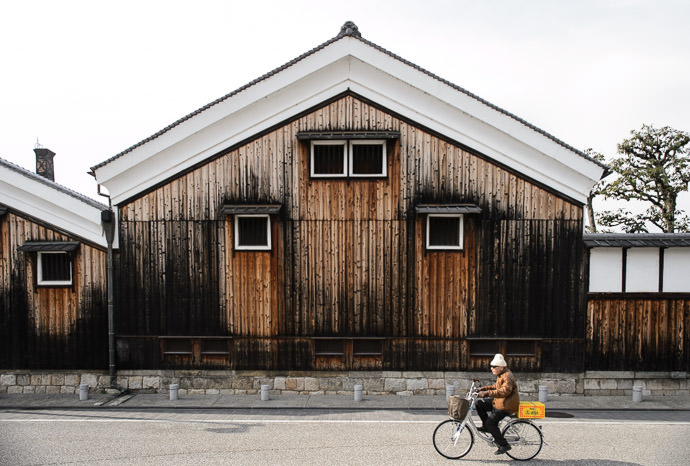
Nikon D4 + Nikkor 24mm f/1.4 — 1/640 sec, f/4, ISO 500 — map & image data — nearby photos
Old Factory Building

Nikon D4 + Nikkor 24mm f/1.4 — 1/2000 sec, f/1.6, ISO 100 — map & image data — nearby photos
“School-Commute Road”
(a natural translation to US English would be “School Zone”)
Wow, it's so convenient that kids can drop in for a quick drink on the way to school! 🙂
The next place we visited had some bicycles parked out front...
... and upon entering it became clear why.... for some reason you're not allowed to ride your bicycle in!
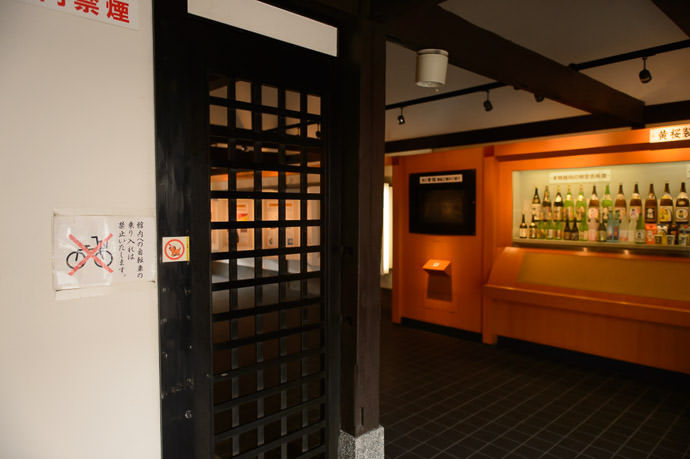
Nikon D4 + Nikkor 24mm f/1.4 — 1/640 sec, f/2.2, ISO 3600 — map & image data — nearby photos
No Bicycles Allowed
in the Kappa Gallery
(also no dogs and no smoking, the latter of which I saw being completely ignored)
Yet another silly sign that makes me wonder what bedlam would befall the place without it.
Actually, to be precise, the sign specifically says that one may not ride a bicycle in, which seems (to me) a bit unnatural unless they explicitly wanted to differentiate riding from not riding. It seems to imply that it's okay so long as you push it. I couldn't test the theory, though, because I didn't have a bicycle on me at the time.
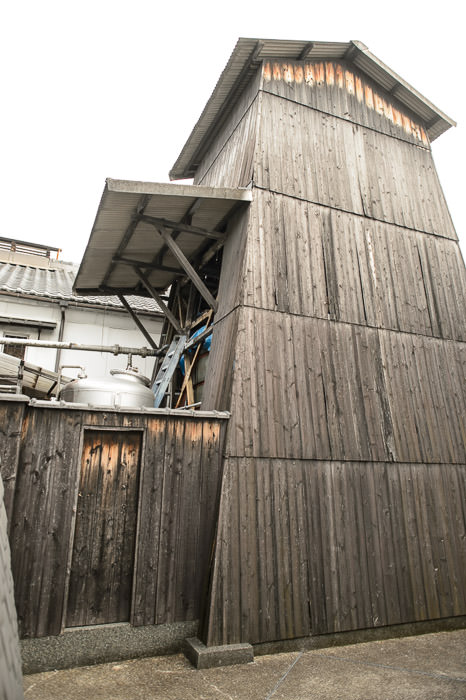
Nikon D4 + Nikkor 24mm f/1.4 — 1/640 sec, f/2.2, ISO 560 — map & image data — nearby photos
Actual Brewing
the heady smell was heavenly
This place had some actual brewing going on, and it smelled wonderful. Otherwise, there wasn't much to recommend a visit.
Two more signs from the walk home...
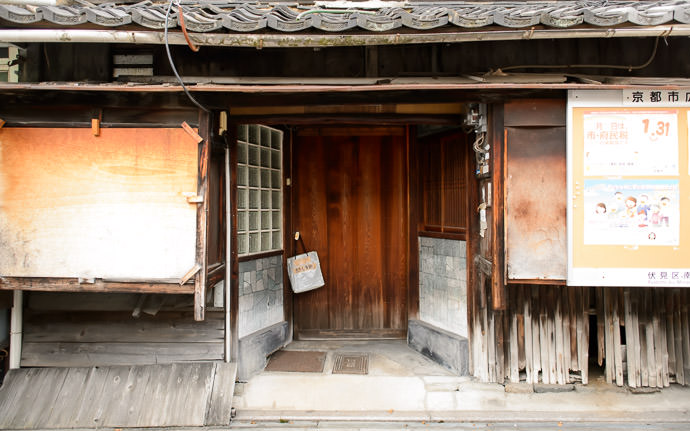
Nikon D4 + Nikkor 24mm f/1.4 — 1/640 sec, f/2.2, ISO 2200 — map & image data — nearby photos
“For Advertising Leaflets”
sign on a bag hanging on the door of an old house
Certain local businesses in Japan advertise incessantly via leaflets shoved in mailboxes (we get several per day), and I can imagine that this homeowner got sick of people ignoring a “no leaflets” sign and littering their doorstep, so perhaps this is a compromise that reduces flying trash.
And finally in a covered mall, notice the biggest sign hanging above the teeming crowd...
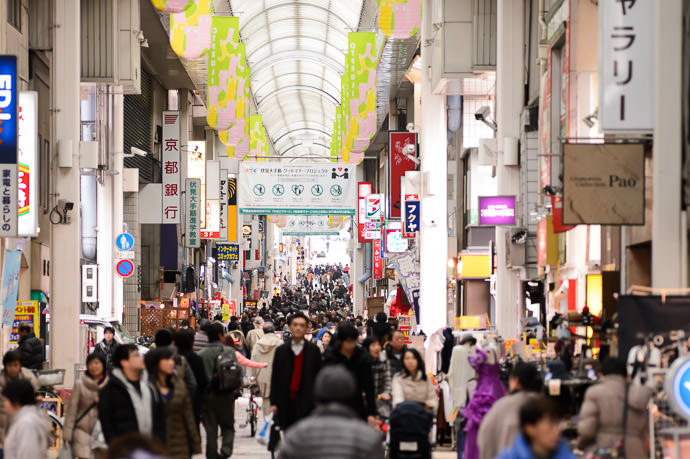
Nikon D4 + Voigtländer 125mm f/2.5 cropped — 1/640 sec, f/2.5, ISO 2500 — map & image data — nearby photos
Waste of Time
If you need to be “reminded”, reminding won't help. The “heart” with the happy smoker reminds us to follow smoking regulations. The non-heart items remind us to not litter, to not walk through the crowd with a lit cigarette, to not ride a bicycle through the crowd, and to not leave your bicycle parked in the way.
And indeed it seems that reminding does not help because none of these seem to be followed.

Nikon D4 + Voigtländer 125mm f/2.5 — 1/640 sec, f/2.5, ISO 1600 — map & image data — nearby photos
What am I?
I came across this today and knew it'd be a great “What am I?” quiz. If you want to cheat, the image metadata includes a hint. Maybe. 😉
As always, I'll keep any guesses private until I reveal the answer in a day or two.






